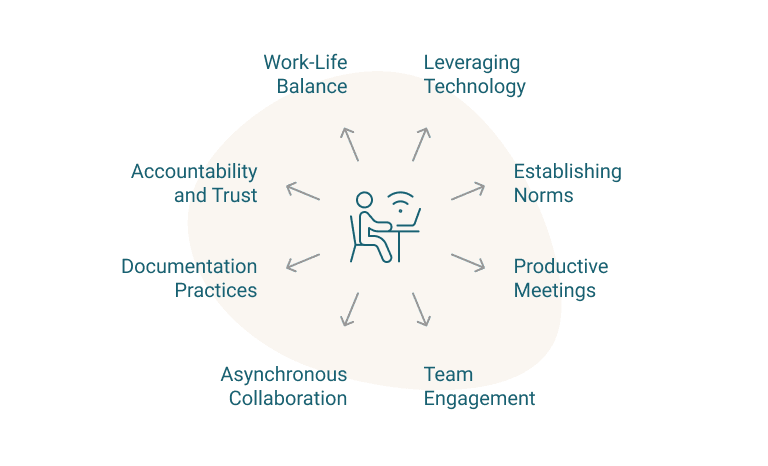project management · Mar 13, 2025
Improve Remote Collaboration: 8 Best Practices for Success

Remote collaboration has become an essential part of modern work environments. With teams spread across different locations and time zones, organizations must adapt to new ways of working together effectively.
However, despite the many benefits of collaborating remotely, challenges such as miscommunication, lack of engagement, and coordination issues often arise.
In this article, we will explore the key aspects of remote collaboration, why it matters, and the common difficulties teams face.
More importantly, we will provide eight best practices to help remote teams collaborate seamlessly. Finally, we will talk about Quire, a powerful tool designed to enhance teamwork and productivity in remote settings.
What Is Remote Collaboration?
Remote collaboration refers to working together as a team, despite being geographically dispersed. Unlike traditional in-office teamwork, remote partnership relies heavily on digital communication tools, project management platforms, and clear operational guidelines to ensure efficiency.
Companies implementing remote collaboration strategies often experience higher productivity, improved employee satisfaction, and reduced operational costs. For example, Zapier, an entirely remote company, has scaled its operations by focusing on strong documentation practices and asynchronous communication, ensuring seamless team collaboration among its employees worldwide.
How Remote Team Collaboration Works Differently
Compared to in-person collaboration, remote teams face distinct challenges, such as:
- Asynchronous Communication: Remote team members may work in different time zones, making instant feedback and discussions more difficult.
- Lack of Non-Verbal Cues: Without in-person interactions, misunderstandings can arise more frequently due to the absence of facial expressions and body language.
- Dependence on Digital Tools: Remote teams heavily rely on project management software, video conferencing, and cloud-based documentation to stay connected and aligned.
8 Practices to Improve Remote Collaboration in the Workplace

Remote collaboration thrives on effective communication, structured processes, and the right tools. Without these, teams face miscommunication, misalignment, and inefficiencies. Here are eight proven strategies to enhance remote teamwork, along with the impact of applying or neglecting them.
1. Leverage Technology for Seamless Collaboration
Technology is the backbone of remote collaboration. Without the right tools, teams may face miscommunication, delayed responses, and difficulty in tracking tasks. Using the right technology can bridge these gaps and facilitate smooth workflows.
How to do it:
- Use Quire to create detailed project timelines, assign tasks, and track progress with real-time updates.
- Hold virtual meetings via Zoom or Google Meet, using breakout rooms for focused discussions.
- Use instant messaging tools (Slack, Microsoft Teams) for quick decision-making and organized conversations.
- Collaborate on documents with Google Docs or Notion, using version history to track edits.
Impact: A global marketing team using Quire benefits from structured workflows, clear accountability, and automated progress tracking. In contrast, teams relying solely on email struggle with slow responses, missed deadlines, and document confusion.
2. Set Clear Guidelines and Work Norms
Without clear expectations, remote teams may struggle with inconsistencies in communication, document handling, and availability. Establishing structured guidelines ensures that everyone is on the same page.
How to do it:
- Establish response time expectations for emails and instant messages.
- Standardize file-naming conventions and store documents in shared spaces like Google Drive or Notion.
- Define core working hours for better coordination across time zones.
Impact: A software team with a "No Meeting Wednesdays" policy and structured Slack channels ensures deep work focus. Without these norms, teams experience constant interruptions, unclear expectations, and inefficiencies.
3. Conduct Productive Meetings
Poorly planned remote meetings can waste time, cause frustration, and reduce engagement. Productive meetings ensure efficient discussions and actionable takeaways.
How to do it:
- Share meeting agendas in advance using Quire or Notion.
- Document discussions and action points in Quire, assigning follow-ups directly.
- Use collaborative tools like Miro for brainstorming and interactive whiteboarding.
Impact: An HR team using Quire for structured meeting notes improves follow-through and accountability. Without meeting structure, teams struggle with vague discussions, leading to lost productivity.
4. Foster Team Engagement and Social Interaction
Remote work can often feel isolating, leading to disengagement and lower morale. Without social interaction, employees may struggle to feel connected to their colleagues.
How to do it:
- Schedule informal virtual coffee chats with Donut (Slack integration).
- Create social Slack channels (e.g., #hobbies, #pets) for casual conversations.
- Organize online team-building events using Kahoot! or virtual escape rooms.
Impact: A remote customer support team hosting monthly virtual events builds stronger connections and collaboration. Without these interactions, employees feel disconnected, affecting engagement and teamwork.
5. Embrace Asynchronous Collaboration
Relying solely on real-time meetings can be challenging due to time zone differences. Without asynchronous collaboration, remote teams may face bottlenecks and delays.
How to do it:
- Use Quire‘s project boards to update tasks asynchronously and track workflows.
- Record important meetings with Loom and share key takeaways in Notion.
- Collaborate via shared documents (Google Docs, Notion) for seamless contributions without time constraints.
Impact: A content team spanning multiple time zones relies on Quire to assign tasks asynchronously, ensuring smooth workflows. Without asynchronous collaboration, progress stalls due to scheduling conflicts.
6. Strengthen Documentation Practices
Lack of documentation in remote teams can lead to miscommunication and knowledge loss. Proper documentation ensures that everyone has access to essential information, reducing dependency on real-time assistance.
How to do it:
- Maintain a knowledge base using Confluence or Notion, linking project guides and SOPs.
- Document detailed workflows in Quire, ensuring tasks include clear instructions and deadlines.
- Regularly update SOPs (Standard Operating Procedures) to reflect new best practices.
Impact: An IT consulting firm using Quire for troubleshooting documentation enables employees to find solutions independently. Without documentation, teams frequently ask redundant questions, reducing efficiency.
7. Promote Accountability and Trust
In remote settings, micromanagement is neither feasible nor productive. A lack of accountability can lead to missed deadlines and reduced motivation.
How to do it:
- Set clear OKRs (Objectives and Key Results) for team members and track them in Quire.
- Use Quire’s task assignments and due dates to hold team members accountable.
- Encourage self-reporting through weekly progress updates in Slack or Notion.
Impact: A product team using Quire for structured check-ins improves transparency and efficiency. Without accountability, unclear priorities cause inconsistent progress and missed deadlines.
8. Maintain Work-Life Balance
Remote work can blur the lines between personal and professional life, leading to burnout. Without clear boundaries, employees may experience stress and decreased productivity.
How to do it:
- Encourage employees to set defined work hours and use Google Calendar to block focus time.
- Support flexible schedules while ensuring deliverables are met through Quire’s deadline tracking.
- Provide mental health resources and encourage breaks with reminder tools like Time Out or Pomodone.
Impact: A tech company enforcing a "no emails after 7 PM" policy reduces burnout and enhances employee well-being. Without boundaries, employees feel pressured to stay online constantly, leading to stress and decreased productivity.
By implementing these practices, remote teams can enhance communication, productivity, and engagement while maintaining a healthy work environment. Without them, teams risk inefficiencies, confusion, and disengagement, ultimately impacting overall performance.
Remote Team Collaboration Tool: Quire
A successful remote collaboration strategy requires the right tools. Quire is designed to streamline teamwork and collaboration, improve transparency, and enhance productivity for remote teams.
How Quire Promotes Remote Collaboration
- Advanced Task Management: Break down complex projects into structured, nested task lists to ensure clear workflows and accountability.
- Real-Time Collaboration: Team members can leave comments, attach files, documents, mention colleagues, and update task statuses instantly, ensuring seamless communication.
- Kanban Board for Visual Progress: Easily switch between task lists and a Kanban board to track project status and manage workloads efficiently.
- Integrations with Essential Tools: Sync with Google Calendar for task scheduling, connect with Slack for instant updates, and integrate with Outlook to streamline communication.
- Transparent Workflow & Reporting: Use detailed progress tracking, filtering options, and analytics to monitor team performance and project milestones.
Conclusion
Effective remote collaboration requires a combination of technology, structured workflows, and strong communication practices. By implementing these eight best practices and leveraging tools like Quire, teams can overcome workplace challenges and maximize productivity in remote settings. Whether you’re a startup, enterprise, or freelancer, improving remote collaboration is the key to long-term success.

